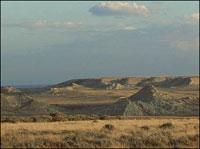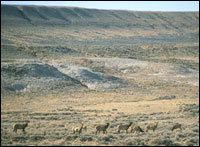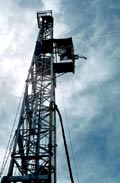OREGON BUTTES, Wyo. Tom Bell remembers how plush the carpet was in Interior Secretary Stewart Udall’s Washington, D.C., office. Bell spent time on his hands and knees there during the 1960s, poring over a large map while making the case for preserving Wyoming’s Red Desert as a national pronghorn antelope refuge.

The Pinnacles in the Red Desert.
Photo: Erik Molvar, Biodiversity Associates.
Udall liked the idea, but encountered a Wyoming congressional delegation that didn’t. More than 30 years later, Bell, a World War II veteran who founded both High Country News and the Wyoming Outdoor Council, is still fighting to preserve the Red Desert. But now the landscape is more threatened than ever, thanks to the rising popularity of coal bed methane extraction.
The Red Desert, which is mostly owned by the U.S. Bureau of Land Management, lies north of Interstate 80 in the heart of southwestern Wyoming’s Green River Basin. The basin is believed to hold 314 trillion cubic feet of coal bed methane (CBM), a form of natural gas. Coal bed methane exploration has boomed in the state’s Powder River Basin, where almost 11,000 CBM wells have been drilled in the last two years.
CBM exploitation, a recently perfected technology, is much more intensive than traditional natural gas extraction. CBM wells in Wyoming are spaced every 80 acres, serviced by power lines, roads, and pipelines, and interspersed with compressor stations. The BLM estimates that Powder River Basin could see 80,000 wells by 2010, and ultimately as many as 139,000, blanketing a region larger than Vermont and New Hampshire combined.
Environmental advocates in the Red Desert and across the West fear the Powder River Basin coal bed methane boom is just a taste of what’s to come. The BLM expects southwestern Wyoming, including the Red Desert, to become “the major natural gas producing region in the United States by 2015.”
Where the Deer and the Antelope Play
The Red Desert is remote to the point of being frightening, a vast area that appears empty yet is paradoxically rich — and not just in buried gas. “I would challenge anyone,” says Mac Blewer, outreach coordinator for the Lander-based Wyoming Outdoor Council, “to find a landscape in America that has such a convergence of nature, culture, and history.”

Elk in the Great Divide Basin.
Photo: Erik Molvar, Biodiversity Associates.
President Clinton’s Interior secretary, Bruce Babbitt, wanted to declare parts of the Red Desert a national monument, but a 1950 amendment to the U.S. Antiquities Act prohibits any such monuments in Wyoming. The Red Desert is the highest desert in North America and home to the largest migratory ungulate herd in the Lower 48; 50,000 pronghorn antelope wander through it each spring and fall, traveling as far as 140 miles. Elk descend from the Wind River range to winter here, and it is home to one of the nation’s healthiest populations of sage grouse, a vanishing species.
Here the Oregon Territory, the Louisiana Purchase, and the Republic of Mexico once came together. A half-dozen historic wagon trails cross the desert, and Bell’s practiced eye can still find them. The Red Desert is also home to the largest collection of BLM wilderness study areas in Wyoming, totaling 117,000 acres.
Nevertheless, says Dan Heilig, executive director of the Wyoming Outdoor Council, “We’re fooling ourselves if we think we’re going to stop mineral development in southwestern Wyoming.” For now, he says, environmentalists are simply trying to keep CBM drillers out of the most striking and sensitive parts of this landscape.
Well, Well, Well
If the nation’s appetite for natural gas grows as expected, it’s only a matter of time before drill rigs show up here — and in New Mexico, Montana, Utah, Colorado, and Washington. Not to mention Texas, Oklahoma, Kansas, Illinois, Pennsylvania, Ohio, West Virginia, Tennessee, Kentucky, Iowa, Arkansas, and Alaska. Gas fields may spring up in all these places — anywhere there is sufficient coal.

A rig problem.
Photo: BLM.
“It’s going to happen around the world,” predicts Walter Merschat, president of Scientific Geochemical Services in Casper, Wyo. “I think any place there’s coal there’s a potential for extracting methane.”
On the eastern edge of the Green River Basin, near Rawlins, the Bureau of Land Management plans to permit 4,000 new CBM wells. More wells are proposed near Pinedale, in the north. The Wyoming Outdoor Council insists that the development of all CBM in the state is illegal, because BLM resource management plans don’t envision it.
“There’s a great history in Wyoming of open abuse and fraud in the oil and gas program,” says Travis Stills, research director for the Oil & Gas Accountability Project. “I don’t think it’s unfair to characterize the current BLM program as suffering from many of those legacies.”
BLM officials counter that they take oil and gas exploration and development into account in their resource management plans — including coal bed methane, even if it was not specifically envisioned.
The Republican-backed energy bill that passed the House in 2001 includes provisions to revive the energy tax credit that first stimulated CBM development. That credit, which was created in 1979 and expired in 1992, was intended to jumpstart unconventional energy sources. The credit still applies to wells drilled before 1992 and funnels about $1 billion per year to the gas industry. A revived credit would produce a $7 billion yearly subsidy, according to OGAP, and accelerate an industry that doesn’t need it.
Black-and-Blue Warrior Basin
CBM was first developed during the late 1980s and early 1990s in Colorado’s northern San Juan Basin and Alabama’s Black Warrior Basin. For those who lived there, it wasn’t pretty.
“This has been a tale of acrimony and lawsuits, environmental degradation, people being displaced from their homes,” said La Plata County, Colo., Commissioner Josh Joswick at an Aug. 31 congressional hearing. La Plata County tried to control CBM development by passing regulations to allow the county to determine where wells would be sited. The gas industry sued to overturn the regulations, but they have been largely held up by the courts.
Now, near Bozeman, Mont., county officials are scrambling to develop similar CBM-drilling rules after several companies leased mineral rights on 78,000 acres. That may be wise.
People who live in places that have coal reserves should “understand it can happen to you,” warns Stills. “We’ve talked to lots of folks who just see coal bed methane as a minor threat out on the horizon. Once the rigs start rolling in, it’s bordering on too late.”


